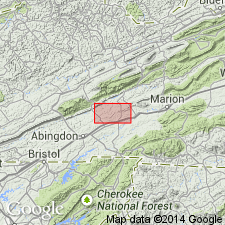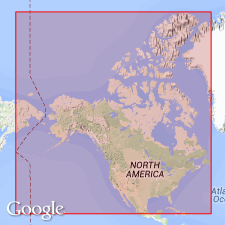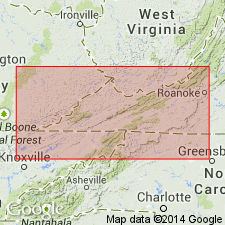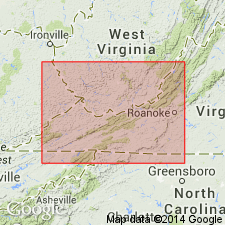
- Usage in publication:
-
- Walker Mountain sandstone member
- Modifications:
-
- Named
- Dominant lithology:
-
- Sandstone
- AAPG geologic province:
-
- Appalachian basin
Summary:
Named the Walker Mountain sandstone member of the Moccasin formation for the southwestern end of Walker Mountain, Washington Co., VA. Consists of 8 to 12 ft of thick-bedded, gray, quartzose sandstone at the top of the formation. Unit overlies the remainder of the Moccasin formation and underlies the Martinsburg formation. The Walker Mountain is of Middle Ordovician age.
Source: GNU records (USGS DDS-6; Reston GNULEX).

- Usage in publication:
-
- Walker Mountain sandstone member
- Modifications:
-
- Overview
- AAPG geologic province:
-
- Appalachian basin
Summary:
No type section was designated by Butts and Edmundson, but the best exposure of the Walker Mountain sandstone member of the Moccasin formation is along Keywood Branch Road about 1/2 mile north of Seven Springs and along VA Highway 91, about 1 mile northwest of McCall Gap, Washington Co., VA. No fossils have been found in this unit.
Source: GNU records (USGS DDS-6; Reston GNULEX).

- Usage in publication:
-
- Walker Mountain Sandstone Member
- Modifications:
-
- Areal extent
- Overview
- AAPG geologic province:
-
- Appalachian basin
Summary:
The Walker Mountain Sandstone Member is a distinctive unit in the Moccasin Formation in the New River Valley of VA and in the Bays Formation in the Bays Mountains of TN and several localities in VA. It is a sequence of yellow to gray to white sandstones with lesser siltstones and shales 0.3 to 15 m thick easily spotted because of its distinct texture and composition. Consists mostly of fine- to coarse-grained to conglomeratic quartz arenites. It is identified here for the first time in the Cove Mountain and Pulaski thrust sheets. Findings of the present research prove the correlation of the Walker Mountain with the middle sandstone of the Bays first suggested by Butts and Edmundson (1943). Correlation is based on the position of the sandstone relative to the Millbrig K-bentonite. Using the bentonites as time lines, it has been determined that the bases of the Eggleston, Bays, and Trenton ("Martinsburg") Formations become younger to the northeast. The Walker Mountain Sandstone Member of the Moccasin and Bays Formations also becomes younger to the northeast. Correlation charts. Cross sections. Measured sections in Appendix.
Source: GNU records (USGS DDS-6; Reston GNULEX).

- Usage in publication:
-
- Walker Mountain Sandstone
- Modifications:
-
- Principal reference
- AAPG geologic province:
-
- Appalachian basin
Summary:
The Walker Mountain Sandstone Member is a widespread sheet deposit in the Bays, Moccasin, and Eggleston Formations of the Valley and Ridge province, of VA and TN. [Outcrop pattern in fig. 1 shows exposure of Walker Mountain or equivalent strata in WV, but locality is not discussed in text.] A type section for the unit is designated here as the exposure on State Road 750, along Keywood Branch, in Washington Co., VA, where it is 2.36 m thick. The Keywood Branch section is in the Big Walker Mountain outcrop belt and was shown on Plate 3 of Butts and Edmundson (1943). It is assigned in this area to the Bays Formation, and lies stratigraphically about 70 m below the top of the formation. (The Bays Formation is about 235 m thick in this area). The Walker Mountain is medium-gray to light olive-gray, weathering very light gray and is a medium- to very thickly bedded, silica-cemented, coarse- to very coarse grained quartz and sublithic arenite with some black chert grains of up to 1.0 cm. Also in this report, the unit is recognized for the first time in the Rich Patch and Warm Springs Valleys, VA, at the base of the Eggleston Formation. Interval was described as "buff quartz arenite" by Kay (1956) in his measured sections of the Eggleston at Richpatch Cove and McGraw Gap. Upper contact of the Walker Mountain is gradational and is defined as the youngest medium to coarse-grained sandstone or the youngest quartz arenite. Lower contact is an unconformity, most recognizable where at the base of the Eggleston or the Bays, the member overlies the Witten, Liberty Hall, or Wassum Formations. Throughout its known area of occurrence, the Walker Mountain occurs below the Millbrig and Deicke K-bentonites, and is considered a significant regional marker bed. Unit is thought to be an equivalent of the Fincastle Conglomerate Member of the Martinsburg Formation.
Source: GNU records (USGS DDS-6; Reston GNULEX).
For more information, please contact Nancy Stamm, Geologic Names Committee Secretary.
Asterisk (*) indicates published by U.S. Geological Survey authors.
"No current usage" (†) implies that a name has been abandoned or has fallen into disuse. Former usage and, if known, replacement name given in parentheses ( ).
Slash (/) indicates name conflicts with nomenclatural guidelines (CSN, 1933; ACSN, 1961, 1970; NACSN, 1983, 2005, 2021). May be explained within brackets ([ ]).

